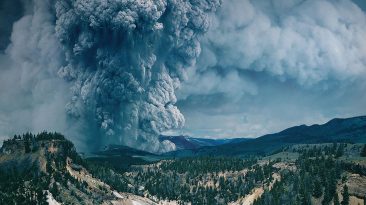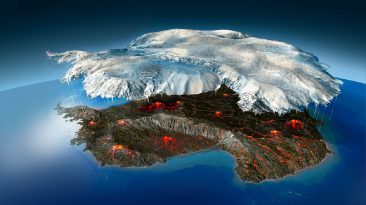Behind you, a colossal hurricane, moments away from making landfall. In front of you, a towering tornado, fast-tracking its way toward the opposing storm. And you. Time’s run out. Escape is futile. Would they merge into a new kind of catastrophe? How much would it be capable of destroying? And can you survive this clash of wind titans?
Hurricanes are formed when a weather disturbance, such as a thunderstorm, moves across an ocean warmer than 26.5 °C (80 °F). The storm pulls in hot and humid air from the warm waters, and condensation continuously feeds the hurricane with more and more clouds. Cooler air rushes in to fill up the low air pressure zone left by all that hot air being forced upward, creating ferocious winds in the process.
A category 5 hurricane, the biggest among them, has a wind speed of 252 km/h (157 mph). And it brings with it the potential for catastrophic damage backed by storm surges as high as 8 m (19 ft). And then you have a tornado. These are rotating columns of wind, extending from the ground all the way up to a thunderstorm. Every one of them requires a supercell to form. Also known as a giant storm.
Tornadoes can stretch as wide as 460 m (1,509 ft). And although they tend to last less than 10 minutes on average, their destructive winds can be well over 320 km/h (200 mph). So what would it look like if these two literal air benders collided? A big part of this showdown would come down to which of these two is more powerful.
In terms of pure might, a tornado’s winds can be stronger than a hurricane’s. And yet hurricanes, unlike tornadoes, last for days instead of just minutes. They are also much larger and tend to cause a lot more damage. It is also not uncommon for tornadoes to form from hurricanes and their giant thunderstorms.
If you were trapped in a really big tempest you could even witness what seems like a whole group of tornadoes colliding with each other. Merging and breaking apart. That’s what scientists call a multi-vortex tornado. It’s a single tornado that has formed anywhere from two to five funnel clouds, rotating around each other.
On the other hand, hurricanes could technically come in contact with each other. If two of them end up less than 1,500 km (900 mi) apart, they may start to rotate around each other in what’s known as the Fujiwara effect. Or, more fittingly, the Fujiwara dance. Now, if two hurricanes come within 300 km (190 mi) of each other, the stronger one can absorb the smaller one.
This is what happened in 1995, when Hurricane Iris and Tropical Storm Karen came in close contact. The two rotated, I mean, danced, around each other before the tougher Iris swallowed poor Karen. But let’s get to the encounter we’re all here for. A tornado and a hurricane meeting head to head. What would it feel to witness their clash?
As the hurricane was approaching you, you’d see a rainstorm. It would be accompanied by strong winds and the eerie sound of early warning sirens. The gusts of wind would build up until they roared. Only yelling would allow you to communicate with others. Sooner rather than later you’d have a hard time remaining on your feet.
Trees would bend, break and even be ripped straight out of the ground. Roofs would be torn off in your neighborhood and fly away like paper airplanes, along with that car you’ve yet to pay off.Uh, bye bye. I mean, not that you’d be able to witness it. The rain would be coming down so hard it would be nearly impossible to see anything at all. And then you’d see it. The massive tornado.
As they got closer, the two storms would start to orbit around each other in an epic Fujiwara dance-off. This swirling whirlwind of an encounter between destructive foes would then end with two possible outcomes. The tornado and the hurricane splitting apart from their dance and going their own way. Or the sheer size of the hurricane absorbing the tornado vortex. Which, I’m sorry to say, wouldn’t be too exciting.
The tornado’s funnel would just dry up and go back into the clouds. In this case, the hurricane would emerge the winner. But, despite the power of its former dance partner, the hurricane’s victory wouldn’t even make it any stronger. Remember, hurricanes can only feed themselves from warm ocean water, not from other storms like tornadoes.
Not that it means you’re out of danger. You’d still better hurry and take shelter. Otherwise, you’d go flying through the air alongside all those newly destroyed rooftops. And although we didn’t end up witnessing a ‘hurr-nado,’ the sight of either of these natural disasters should tell you it’s time to run for cover. But if you’re still craving fireworks and mayhem, how about dumping an active volcano into the path of your tornado?
Sources
- “How Do Hurricanes Form? | NASA Space Place – NASA Science For Kids”. 2022. spaceplace.nasa.gov.
- “How Does The Ocean Affect Hurricanes? : Ocean Exploration Facts: NOAA Office Of Ocean Exploration And Research”. 2022. oceanexplorer.noaa.gov.
- “What Is The Difference Between A Tornado And A Hurricane? | NASA Global Precipitation Measurement Mission”. 2022. gpm.nasa.gov.
- “The 10 Deadliest US Tornadoes On Record”. Gabrielle Sorto. 2019. cnn.com.
- “How Can A Tornado Last For Hours?”. Nicole Mortillaro. 2015. globalnews.ca.



























